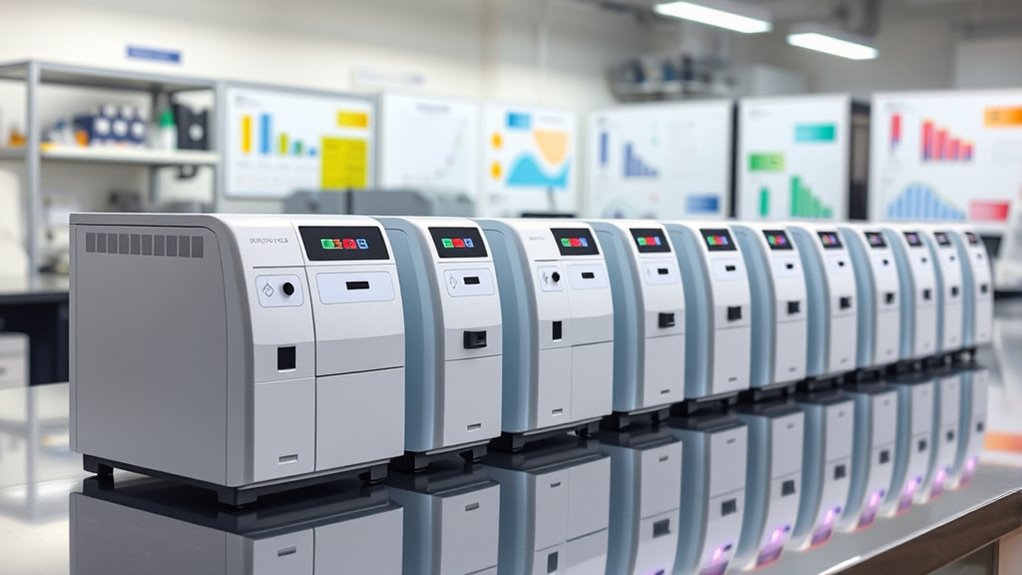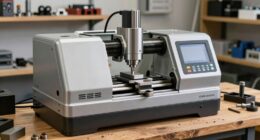If you’re searching for the 15 best microarray scanners of 2025, I’ve reviewed top models designed for precise, high-resolution results. These scanners combine advanced optical systems, fast throughput, and user-friendly features suitable for research or diagnostics. Many support high-density arrays, batch processing, and seamless software integration. To guarantee you pick the right tool for your needs, keep an eye on features like calibration, connectivity options, and maintenance requirements—stay with me to explore these options further.
Key Takeaways
- Top models feature high-resolution imaging (2-3µm/pixel) for detailed microarray analysis accuracy.
- Advanced optical systems with calibration and validation ensure consistent, reliable results.
- Compatibility with analysis software and cloud integration streamlines data management and processing.
- Portable, user-friendly designs with touchscreen interfaces enhance efficiency in various environments.
- High-speed scanning and batch processing capabilities optimize throughput for professional research use.
Epson Workforce ES-580W Wireless Document Scanner

The Epson Workforce ES-580W Wireless Document Scanner is an excellent choice for anyone who needs fast, wireless scanning without the hassle of connecting to a computer. It offers high-speed, duplex scanning at up to 35 pages per minute, making large jobs quick and efficient. With its 100-sheet Auto Document Feeder, it handles various paper types and sizes seamlessly. The intuitive 4.3-inch touchscreen makes operation straightforward, while wireless connectivity lets you scan directly to smartphones, tablets, or cloud services like Dropbox and Google Drive. Plus, with OCR technology, it creates searchable PDFs and editable files, streamlining your document management effortlessly.
Best For: professionals and small offices needing fast, wireless, high-volume document scanning with easy-to-use features.
Pros:
- Wireless connectivity allows direct scanning to devices and cloud services without a computer
- High-speed duplex scanning up to 35 pages per minute for efficient large-volume tasks
- User-friendly 4.3-inch touchscreen simplifies operation and navigation
Cons:
- May be relatively expensive for casual or infrequent scanning needs
- Larger footprint due to the Auto Document Feeder and touchscreen design
- Requires Wi-Fi for wireless features, which could be a limitation in some network environments
CZUR Shine Ultra Portable Document Scanner with OCR, USB Camera for Windows & Mac
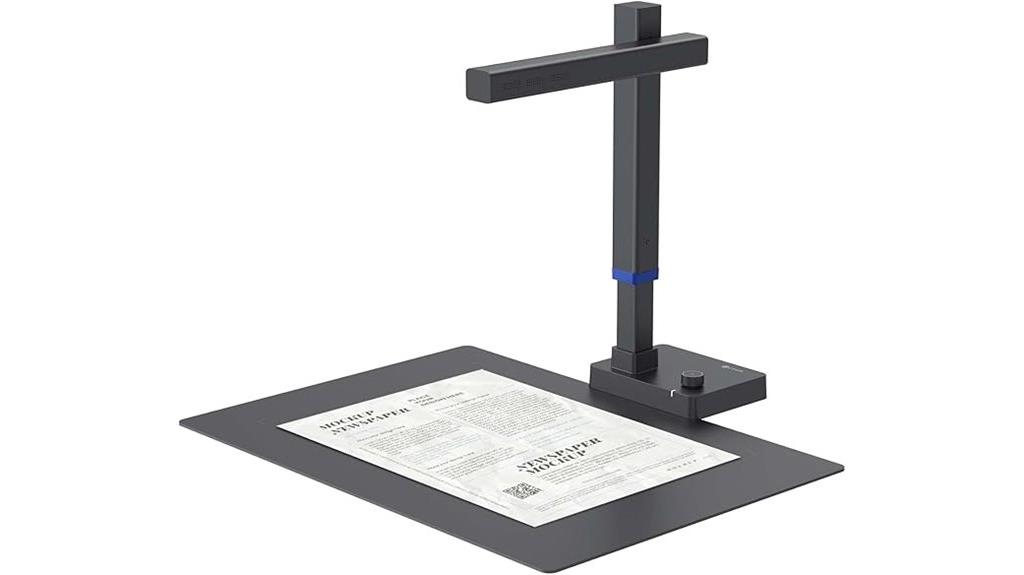
If you need a portable scanner that smoothly combines high-resolution imaging with versatile functionality, the CZUR Shine Ultra is an excellent choice. Designed for desktop or laptop use, it’s compatible with Windows and macOS, supporting flat papers up to A3 and A4, and small objects at rapid speeds. Its lightweight, foldable design features a 13MP CMOS camera, offering high-resolution scans and smart features like auto cropping and side combining. Perfect as a document camera for remote teaching or digitizing documents with OCR technology, it’s ideal for users needing fast, accurate scans on the go. Its user-friendly design and versatile features make it one of the top portable scanners in 2025.
Best For: professionals, educators, and students who need a portable, high-resolution scanner for digitizing documents, books, and objects quickly and accurately on the go.
Pros:
- Compact, lightweight, and foldable design for easy portability and storage
- High-resolution 13MP CMOS camera with smart features like auto cropping and side merging for clear scans
- Compatible with Windows and macOS, supporting a wide range of file formats and OCR for editable documents
Cons:
- Not compatible with Android or iOS devices, limiting mobile connectivity options
- Designed primarily for flat papers and thin books, less effective for thick or hardcover books without the ET series
- Some users may find the scanning speed or software features less suitable for heavy-duty professional use
Shining 3D Einstar Handheld 3D Scanner
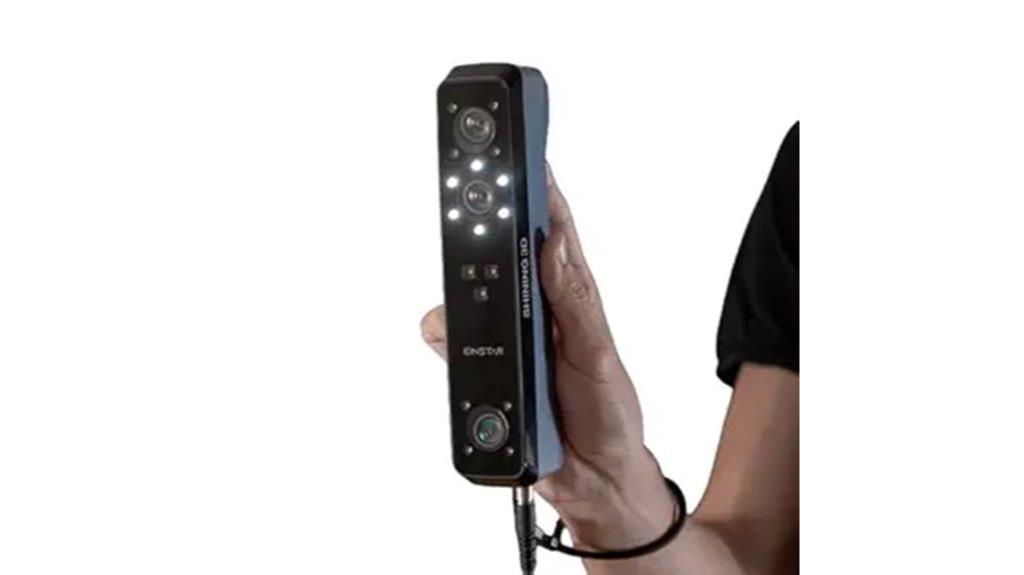
For professionals seeking high-precision 3D scanning in a handheld device, the Shining 3D Einstar stands out thanks to its rapid data capture and exceptional color fidelity. It collects high-density point cloud data quickly, with point distances up to 0.1mm, and features an RGB color camera for detailed, true-to-life color capture. Its intelligent software enhances data quality, supports automatic alignment, and streamlines workflow. With a scanning speed of up to 14 FPS and outdoor capabilities, Einstar handles diverse objects effortlessly. Compatible with multiple formats like OBJ and STL, it’s ideal for 3D printing, design, and digital archiving, ensuring accurate results across various applications.
Best For: professionals and enthusiasts seeking high-precision, handheld 3D scanning with rich color detail for applications like 3D printing, design, and digital archiving.
Pros:
- Rapid data capture with high-density point cloud data up to 0.1mm point distance.
- Built-in RGB camera provides high color fidelity for realistic 3D models.
- Supports outdoor scanning and multiple data formats, enhancing versatility.
Cons:
- May require a learning curve for optimal software use and data processing.
- The device’s cost might be high for casual or hobbyist users.
- Limited information on battery life or portability for extended outdoor use.
Plustek OpticFilm 8300i Ai Film Scanner
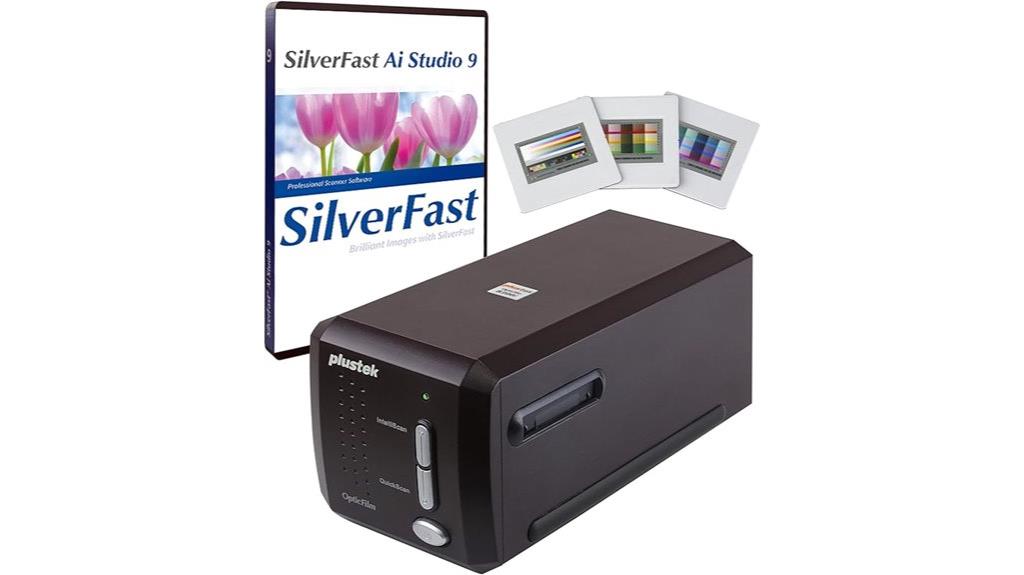
Designed for photographers and archivists who demand precise color reproduction, the Plustek OpticFilm 8300i Ai Film Scanner offers a significant upgrade with its 38% faster scan speed powered by a new generation chip. It converts 35mm film and slides into high-quality digital images, supporting both Windows and Mac OS. The scanner comes with professional software like SilverFast 9 Ai Studio and Plustek QuickScan Plus, ensuring efficient digitization. Its advanced calibration tools, including three IT8 targets, guarantee accurate color reproduction with minimal interpolation. Compact and lightweight, it’s backed by US-based support, making it a reliable choice for those serious about archival quality.
Best For: photographers and archivists seeking precise color reproduction and high-quality digitization of 35mm film and slides.
Pros:
- Faster scan speed with a 38% improvement over previous models, saving time during digitization
- Includes professional-grade SilverFast 9 Ai Studio software with advanced image optimization tools
- Accurate color calibration with three IT8 targets ensuring minimal interpolation and true color reproduction
Cons:
- Relatively heavy at 6.03 pounds, which might affect portability for some users
- Limited to 35mm film and slides, not suitable for other film formats
- Higher price point due to professional features and calibration tools
Plustek OpticFilm 8200i SE 35mm Film & Slide Scanner
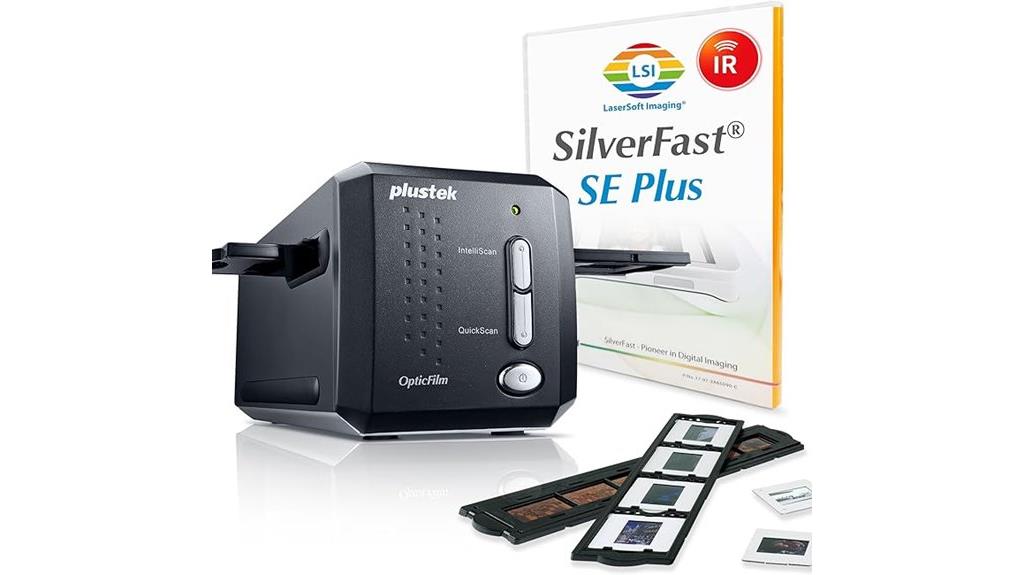
The Plustek OpticFilm 8200i SE stands out as an excellent choice for photographers and archivists who need high-resolution scans of 35mm negatives and slides. It supports up to 7200 dpi resolution, providing detailed, high-quality images. The scanner features 48-bit input and 24/48-bit output, ensuring rich color depth, and includes Silverfast SE Plus 9 software for enhanced editing. Its built-in infrared channel automatically detects dust and scratches, removing defects effortlessly. Compact and lightweight, it’s compatible with both Windows and Mac systems. Overall, it offers reliable performance, making it ideal for preserving and digitizing precious film collections with professional results.
Best For: Photographers and archivists seeking high-resolution, detailed scans of 35mm negatives and slides for professional preservation and digitization.
Pros:
- Supports high resolutions up to 7200 dpi for detailed image quality
- Built-in infrared channel automatically detects and removes dust and scratches
- Compatible with both Windows and Mac systems, including latest OS versions
Cons:
- Customer ratings average around 3.9 stars, indicating mixed reviews on performance and reliability
- Relatively bulky design at over 4.7 inches in height and nearly 3.5 pounds in weight
- May require familiarity with Silverfast software for optimal use, which could have a learning curve
Shining 3D Einstar Vega Wireless 3D Scanner
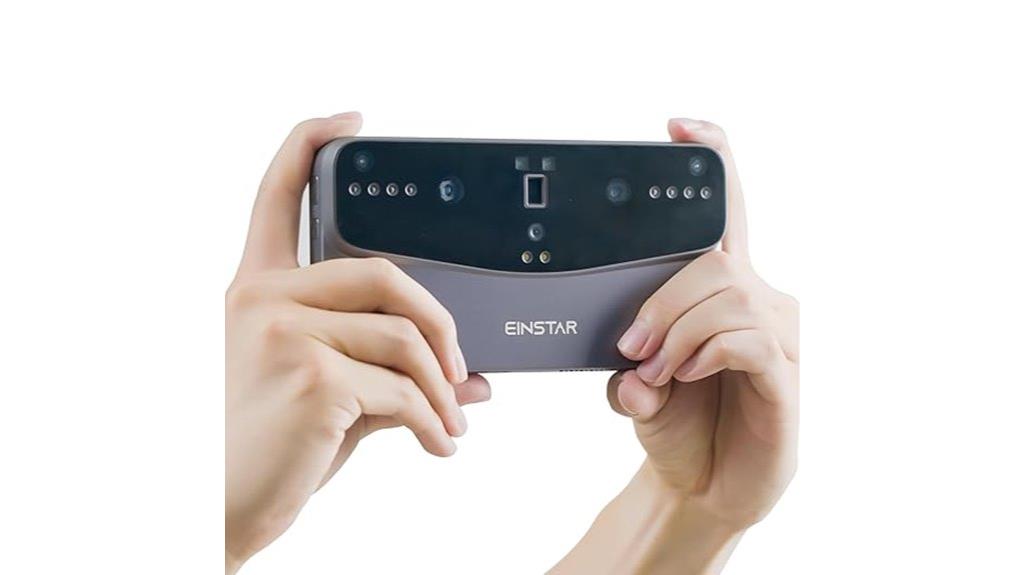
If you need a versatile 3D scanner that combines portability with high-quality data capture, the Shining 3D Einstar Vega Wireless 3D Scanner is an excellent choice. It features an all-in-one handheld design with integrated VCSEL and MEMS projectors, a powerful 8-core CPU, 32GB RAM, and a 512GB SSD, plus a bright 2K AMOLED display. Its dual scanning modes—long-range VCSEL and high-resolution HD—ensure fast, detailed results for various object sizes. The infrared light source makes outdoor scanning reliable, even in sunlight or dark environments. Wireless connectivity, cloud data sharing, and advanced software tools simplify workflows, making it suitable for both beginners and professionals.
Best For: professionals and enthusiasts seeking a portable, high-precision 3D scanner suitable for various environments and object sizes.
Pros:
- Combines dual scanning technologies (VCSEL and HD MEMS) for versatile, fast, and detailed scanning.
- Wireless connectivity and cloud sharing simplify workflows and enable on-the-go use.
- All-in-one handheld design with a high-resolution AMOLED display enhances usability and portability.
Cons:
- High-end specifications may come with a premium price point.
- Large file sizes could require substantial storage and processing power.
- Learning curve for advanced software features might be challenging for complete beginners.
Brother DS-740D Duplex Compact Mobile Document Scanner
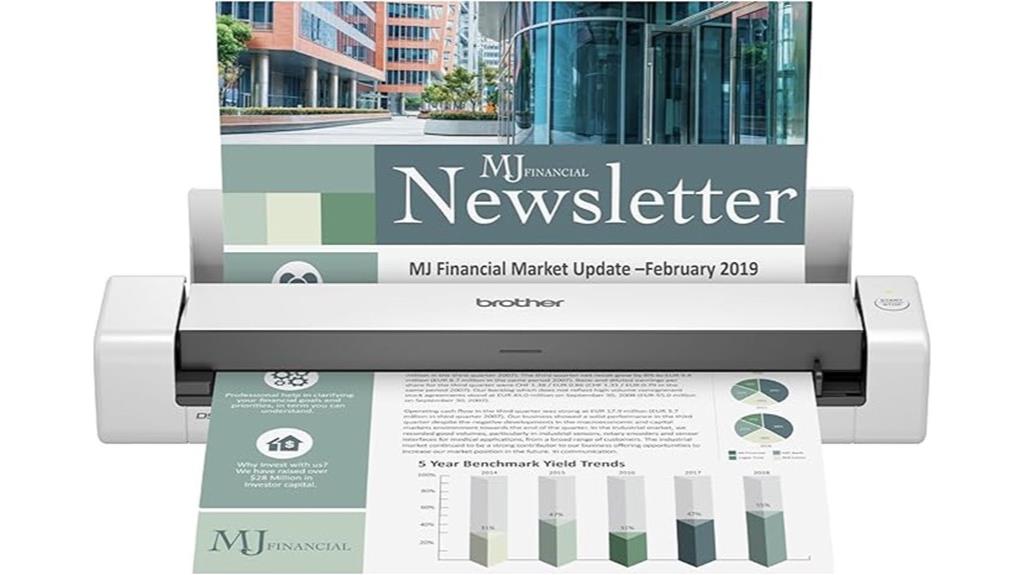
For professionals who need a portable and efficient scanner, the Brother DS-740D Duplex Compact Mobile Document Scanner stands out as an ideal choice. Its lightweight design (just 2.24 pounds) and compact size make it easy to carry, fitting into bags or pockets for on-the-go use. The Desk Saving Design reduces desk space by 11 inches, and the roller system eliminates the need for extra behind-the-scanner space. It scans both sides of receipts, IDs, and documents at up to 16 pages per minute, ensuring quick, high-quality results. With broad software compatibility and OCR features, it simplifies digitization, storage, and sharing, perfect for busy professionals.
Best For: mobile professionals and small offices seeking a lightweight, fast, and versatile scanner for on-the-go document digitization.
Pros:
- Compact and lightweight design (2.24 pounds) for easy portability
- Fast duplex scanning at up to 16 pages per minute, saving time
- Broad software compatibility with OCR and image enhancement features
Cons:
- Occasional paper jams that require unplugging and replugging the device
- Hard-to-open cover may affect ease of use
- Limited to scanning documents and IDs; cannot scan from bound books
ScanSnap iX2500 Wireless and USB Document Scanner with Touchscreen
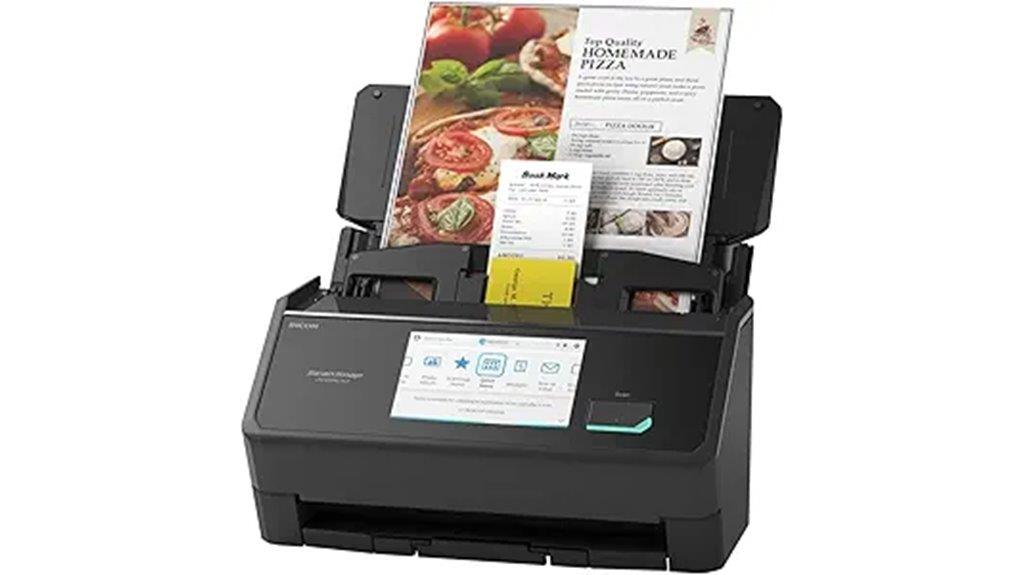
Anyone seeking a fast, reliable scanner that combines ease of use with advanced connectivity will find the ScanSnap iX2500 an ideal choice. Its elegant design and robust build, featuring a large touchscreen, make operation intuitive. With a 100-sheet capacity and duplex scanning at 45 pages per minute, it handles high-volume tasks effortlessly. Built-in Wi-Fi 6 and USB-C ensure quick, secure connections across Mac, PC, iOS, and Android devices. It supports cloud services like Dropbox and Google Drive, plus direct scanning via ScanSnap Cloud. Automatic features like auto-cropping and OCR make digitization seamless, while customizable profiles enhance user experience. It’s a versatile, efficient addition to any workspace.
Best For: professionals and small offices seeking a high-speed, reliable, and easy-to-use scanner with advanced connectivity and automation features.
Pros:
- Fast duplex scanning at 45 pages per minute with high-quality image output.
- Seamless wireless and USB-C connectivity supporting multiple devices and cloud services.
- Intuitive large touchscreen and customizable software profiles enhance user experience.
Cons:
- Relatively heavy at 7.7 pounds, which may impact portability.
- Premium price point may be a consideration for budget-conscious buyers.
- Some users might require additional setup time for advanced features and cloud integrations.
CZUR ET24 Pro Book Scanner with 24MP Camera and Auto-Flatten Tech
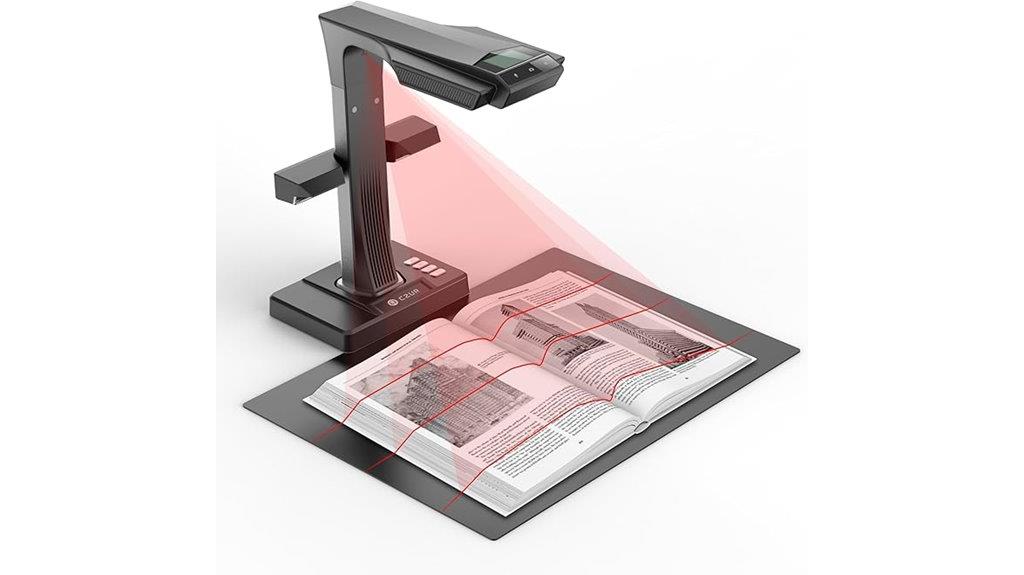
The CZUR ET24 Pro Book Scanner stands out as an ideal choice for researchers, archivists, and professionals who need high-quality digitization of large-format materials. Its 24MP HD camera captures detailed images at 320 DPI, perfect for books, documents, and artwork up to A3 size. The advanced auto-flatten technology guarantees curved pages and 3D surfaces are fully flattened, producing crisp scans. With support for Windows, macOS, and Linux, plus HDMI connectivity, it offers fast, stable data transfer. The software provides OCR for searchable files and batch processing, although it has some limitations. Overall, it’s a versatile, reliable scanner tailored for high-volume digitization tasks.
Best For: researchers, archivists, and professionals who require high-quality digitization of large-format materials such as books, documents, and artwork.
Pros:
- High-resolution 24MP camera with 320 DPI for detailed scans of various materials
- Advanced auto-flatten technology effectively flattens curved pages and 3D surfaces
- Supports multiple operating systems (Windows, macOS, Linux) and HDMI for stable, fast data transfer
Cons:
- Software can crash after processing 450-500 pages and has limited editing features
- Expensive investment despite its professional capabilities
- Foot pedal may be lightweight and short in cable length, affecting stability and ease of use
Plustek OpticFilm 135i Ai Film & Slide Scanner
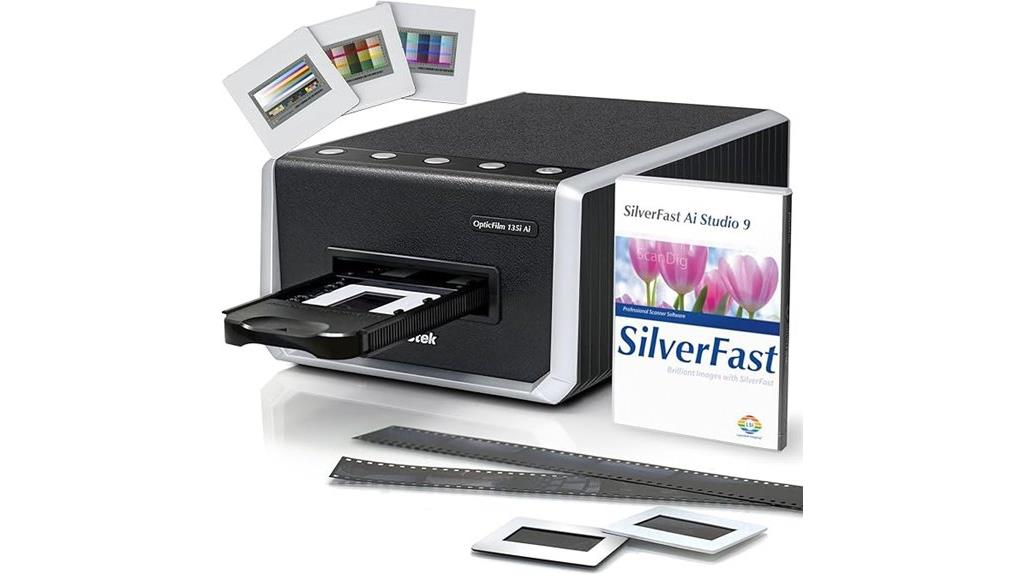
The Plustek OpticFilm 135i Ai Film & Slide Scanner stands out with its advanced 3rd Generation 5-element lens, which markedly reduces light refraction and guarantees exceptional image stability—especially at the edges. This design enhances infrared dust and scratch detection, thanks to minimized IR image plane defocus, boosting MTF by up to 200%. It supports various 35mm film formats, including panoramic and half-frame, with an optional panoramic holder. The scanner enables batch scanning of slides and negatives, increasing efficiency. Coupled with SilverFast Ai Studio 9 software and an IT8 calibration target, it ensures precise color accuracy and stunning detail, making it ideal for professional archiving and high-quality reproductions.
Best For: Professional photographers, archivists, and high-end hobbyists seeking precise, high-resolution film scans with advanced color calibration and dust/scratch removal.
Pros:
- Exceptional image resolution with advanced lens technology that reduces refraction and enhances edge stability.
- Supports a wide range of 35mm film formats, including panoramic and half-frame, with optional dedicated holders.
- Includes SilverFast Ai Studio 9 software and IT8 calibration target for accurate color reproduction and detailed editing.
Cons:
- May have a higher price point due to its professional-grade features and advanced hardware.
- Bulkier design could be less convenient for casual or portable scanning needs.
- Requires familiarity with professional scanning software, which might have a steeper learning curve for beginners.
Revopoint MIRACO Plus 3D Scanner for 3D Printing

If precision and versatility are top priorities in your 3D printing projects, the Revopoint MIRACO Plus 3D Scanner stands out as an ideal choice. It offers 0.02 mm accuracy with high-resolution capture of small details on large objects, thanks to its advanced photogrammetric technology. Its quad depth camera system adapts to both tiny components and big machinery, while infrared zoom captures surface nuances with less noise. Powered by an 8-core processor and 32GB RAM, it handles up to 10,000 frames smoothly. Lightweight and portable, it integrates seamlessly with various software formats, making detailed, accurate 3D scans quick and easy for professional use.
Best For: professionals and hobbyists requiring high-precision 3D scanning for detailed reverse engineering, product design, and 3D printing projects.
Pros:
- Achieves 0.02 mm accuracy with high-resolution detail capture on large objects
- Versatile quad depth camera system that adapts to both small components and large machinery
- Portable design with lightweight build and quick data transfer options
Cons:
- Battery life limited to approximately 2 hours per charge, which may require frequent recharging during extended use
- Advanced features and software may have a learning curve for new users
- Higher price point compared to entry-level 3D scanners, potentially limiting accessibility for casual users
Plustek PS186 Desktop Document Scanner with 50-Page ADF
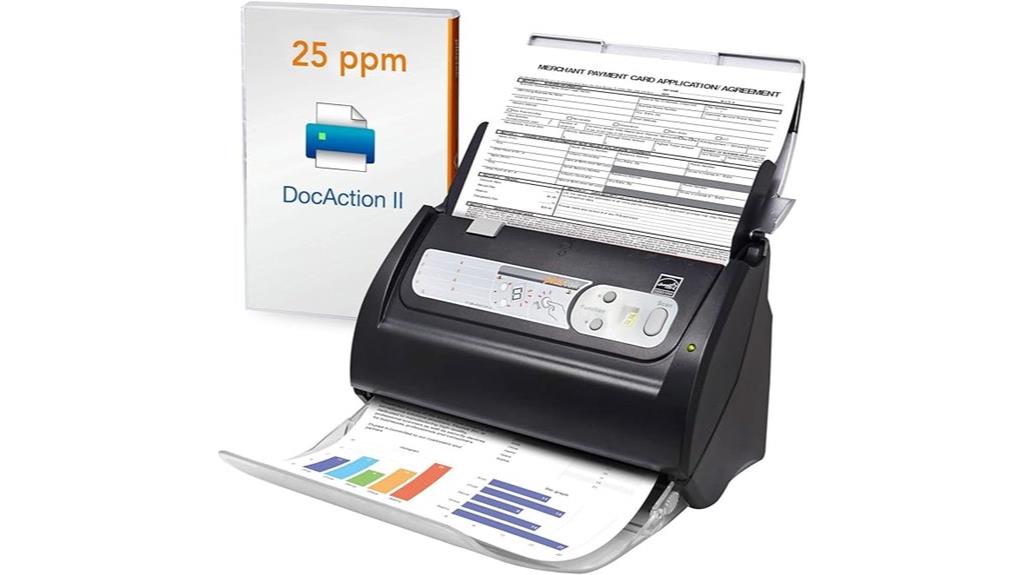
Looking for a reliable scanner that keeps up with high-volume document workflows? The Plustek PS186 Desktop Document Scanner fits that need perfectly. It has a 50-page Automatic Document Feeder, making bulk scanning quick and efficient. It supports Windows 7 through 11 on both Intel and AMD systems, ensuring broad compatibility. With up to 255 customizable scan settings, you can personalize your workflow for maximum productivity. It also converts paper documents into searchable PDFs using OCR, making editing easy. Advanced features like barcode recognition and intelligent image adjustments streamline complex tasks. Plus, files can be easily transferred to FTP or NAS, simplifying file management.
Best For: professionals and small offices handling high-volume document scanning who need efficient, customizable workflows and advanced document management features.
Pros:
- Supports high-capacity 50-page ADF for quick bulk scanning
- Up to 255 customizable scan settings for personalized workflows
- Converts documents into searchable PDFs with OCR and auto-categorization via barcode recognition
Cons:
- Compatibility limited to Windows 7 through 11, no Mac support
- Requires driver downloads from the website, which may add setup time
- May be overkill for low-volume or casual scanning needs
ScanSnap iX1400 High-Speed Document Scanner with Auto Document Feeder

For busy professionals and home office users, the ScanSnap iX1400 stands out with its one-touch scanning and quick access features, making document management effortless. With a simple press of a button, you can scan, clean, and organize a variety of documents effortlessly. The QUICK MENU feature provides quick access to your favorite applications, streamlining workflow. It handles diverse paper types like receipts, business cards, photos, and envelopes, ensuring versatility. Operating via a stable USB connection, it guarantees reliable performance. Automatic image enhancement removes streaks, blanks, and adjusts rotation, delivering high-quality, ready-to-use scans every time.
Best For: busy professionals and home office users seeking a reliable, versatile, and easy-to-use document scanner for efficient digital organization.
Pros:
- One-touch scanning with quick access features simplifies workflow.
- Handles a wide range of paper types including photos, receipts, and business cards.
- Automatic image enhancement ensures high-quality, ready-to-use scans without manual adjustments.
Cons:
- Operates exclusively via wired USB connection, limiting portability.
- May require additional software setup for optimal organization and management.
- Limited to document scanning; does not support advanced features like duplex scanning or OCR integration out of the box.
Plustek OpticPro A320E Flatbed Scanner
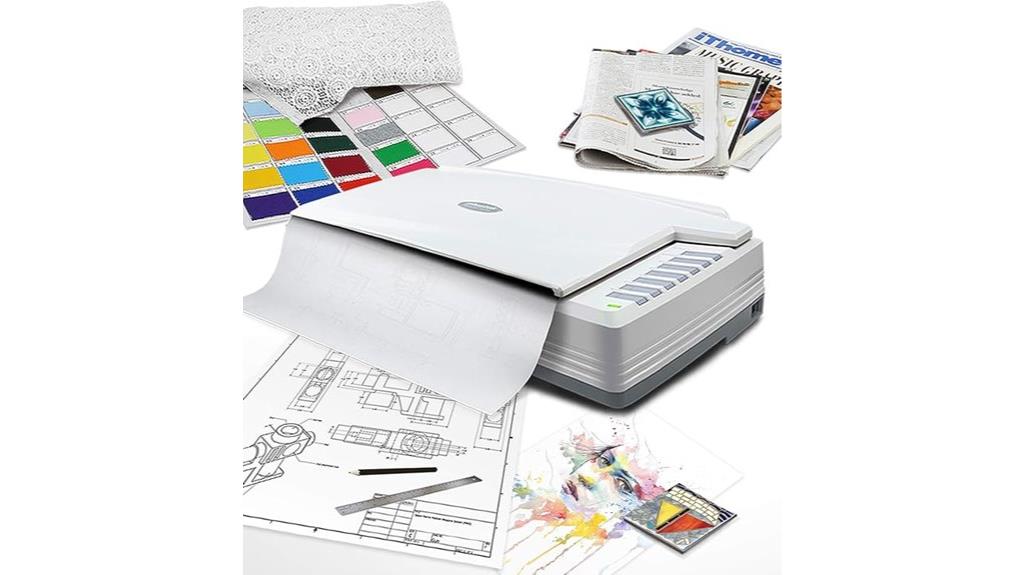
The Plustek OpticPro A320E flatbed scanner stands out for its large 12×17 inch scan area, making it an excellent choice for professionals and hobbyists who need to digitize oversized documents, maps, or artwork. It scans quickly at 7.8 seconds per scan and features a CCD sensor with Toshiba 800 dpi imaging elements, though some users report lower actual resolutions. The scanner supports multiple file formats, batch scanning, and OCR for searchable PDFs. Compatible with Windows, Mac, and Linux, it offers physical buttons for quick operation. However, software limitations and resolution concerns may affect image sharpness, especially for detailed professional work.
Best For: professionals and hobbyists needing to digitize large-format documents, artwork, or maps quickly and affordably.
Pros:
- Supports large 12×17 inch scan area suitable for oversized materials
- Fast scanning speed of 7.8 seconds per scan for efficient digitization
- Compatible with Windows, Mac, and Linux, with batch scanning and OCR features
Cons:
- Software limitations may require external programs like VueScan for advanced features
- Actual resolution may be lower than claimed, resulting in less sharp images upon zooming
- Some users report reliability issues and difficulty using the one-touch buttons effectively
Ambir ImageScan Pro 820ix for use with athenahealth,Black
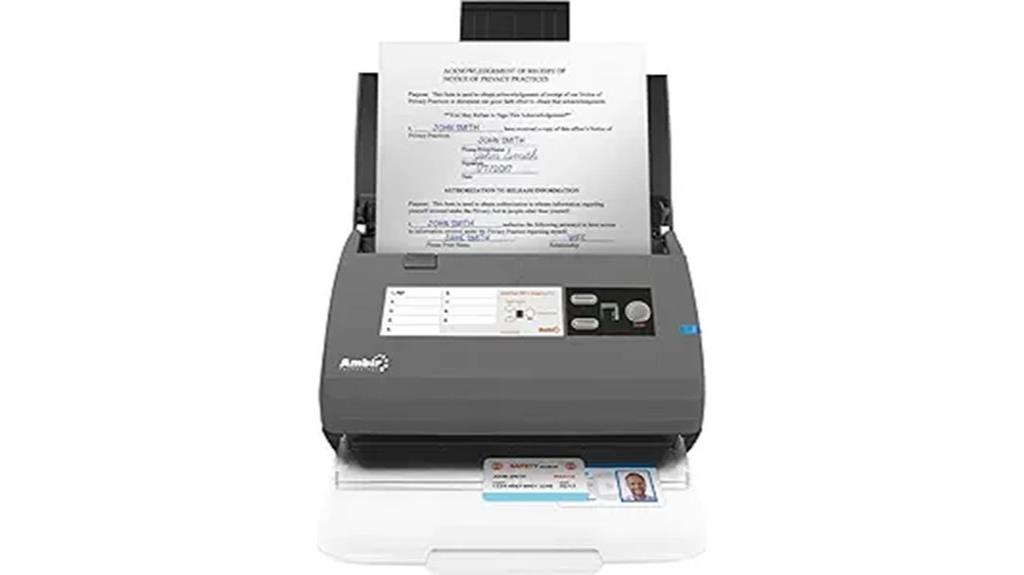
Designed specifically for medical practices that use athenahealth, the Ambir ImageScan Pro 820ix offers a reliable, high-speed scanning solution in a compact form. It scans up to 20 pages per minute and handles up to 3,000 pages daily, making it perfect for busy clinics. Its duplex scanning captures both sides in a single pass, saving time. The high-capacity automatic feeder holds 50 pages, ideal for bulk tasks. With preset scan profiles, especially for cards and documents upload into athenaNet, it streamlines workflows. Its durable, professional-grade build guarantees consistent performance, all while occupying less space and consuming minimal energy.
Best For: medical practices, urgent care clinics, and hospitals seeking a reliable, high-speed scanner optimized for athenahealth integration and high-volume back-office tasks.
Pros:
- Fast scanning speed of 20 pages per minute with duplex capability, increasing efficiency.
- Compact design with a small footprint, ideal for space-constrained environments.
- Preset scan profiles for quick document and card uploads into athenaNet, streamlining workflows.
Cons:
- Limited color options, available only in black.
- May require initial setup for optimal profile customization.
- Primarily designed for medical and legal documents, potentially less versatile for general office use.
Factors to Consider When Choosing Microarray Scanners
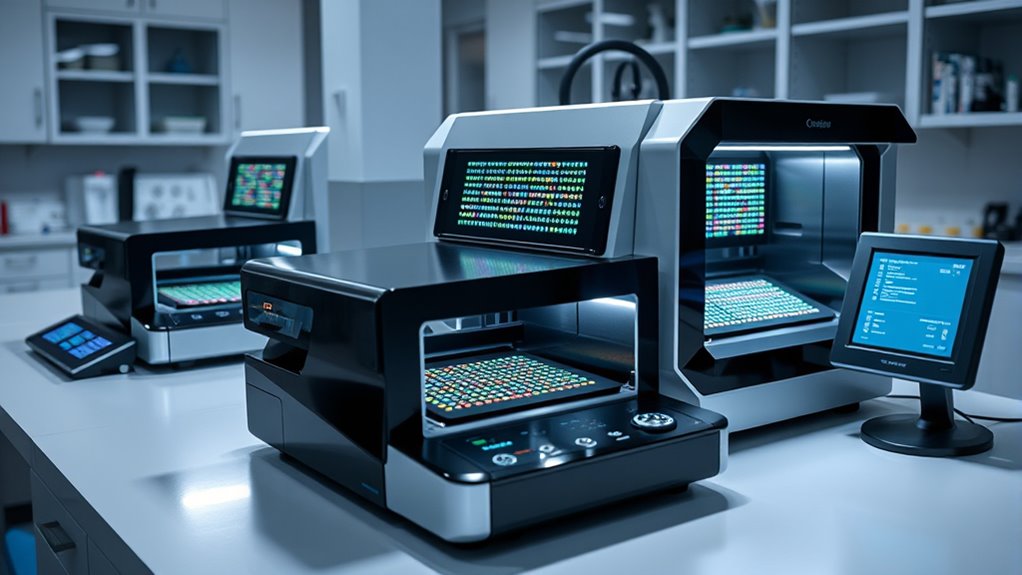
When choosing a microarray scanner, I focus on key factors like resolution and detail accuracy to guarantee precise data. Speed and throughput matter too, especially for handling larger sample volumes efficiently. Additionally, I consider software compatibility, sample capacity, and calibration features to find the best fit for my needs.
Resolution and Detail Accuracy
Choosing a microarray scanner with the right resolution is essential for accurate data interpretation. Higher resolution scanners, supporting at least 2-3 micrometers per pixel, allow detailed spot detection, which is indispensable for high-density arrays with thousands of features. Precise resolution helps distinguish closely spaced probes and captures subtle intensity differences, critical for reliable gene expression analysis. The optical system, including lens quality and sensor pixel size, primarily determines a scanner’s resolving power. To guarantee consistent detail accuracy, regular calibration and validation against known standards are necessary to reduce measurement variability. Investing in a scanner with ideal resolution ensures your results are both accurate and reproducible, making it a key factor in selecting the best model for your research needs.
Throughput and Speed Capabilities
Optimizing throughput and speed capabilities is key to maximizing laboratory efficiency when selecting a microarray scanner. The scanner’s throughput, measured by how many slides or arrays it can process per hour, directly impacts overall productivity. High-speed models can analyze hundreds of arrays daily, depending on resolution and data processing times. Speed is affected by factors like image acquisition time, data transfer rates, and processing algorithms. Many top scanners incorporate advanced hardware, such as multiple camera arrays or parallel processing, to boost throughput without sacrificing data quality. Balancing speed and throughput ensures workflow demands are met efficiently, enabling timely results while maintaining high resolution and accuracy. Choosing a scanner that aligns with your lab’s volume and processing needs is crucial for peak performance.
Compatibility With Software
Ensuring compatibility between your microarray scanner and analysis software is vital for smooth data workflows. I always verify that the scanner works seamlessly with software like GenePix, ScanArray, or ArrayPro, as this simplifies data transfer and processing. It’s also important to confirm that the scanner supports your operating system, whether Windows, Mac, or Linux, to prevent any compatibility issues. I check if the scanner’s drivers are regularly updated and compatible with the latest software versions, guaranteeing peak performance. Additionally, I verify the scanner can export data in formats such as TIFF, JPEG, or proprietary types supported by my analysis tools. Finally, I look for API or SDK support in the control software, which allows for custom integration and automation within my existing data management systems.
Sample Size and Capacity
The sample size and capacity of a microarray scanner play a essential role in determining how efficiently I can process experiments. A higher capacity means I can handle more arrays or slides in a single run, boosting throughput and saving time. Larger scanners with multiple input channels or stacked trays allow me to process high-density arrays or multiple slides simultaneously, which is critical for large-scale projects. The physical size of the input tray also affects how many samples I can load without frequent reloading, reducing downtime. Selecting a scanner with the right capacity ensures my workflow remains smooth and productive. It helps prevent bottlenecks, especially when handling extensive experiments, allowing me to focus on data analysis rather than equipment limitations.
Calibration and Color Precision
When selecting a microarray scanner, paying close attention to calibration and color precision can make a significant difference in the quality of your data. Accurate calibration guarantees that the scanner’s color output matches standardized profiles, minimizing discrepancies in images. High-precision color reproduction depends on the scanner’s ability to consistently capture subtle color differences across different batches or runs. Regular calibration using IT8 targets or similar tools is essential to maintain color fidelity over time. A wide dynamic range enables better differentiation of faint or overlapping signals, boosting data accuracy. Proper color management workflows—calibration and profiling—are crucial for reliable quantitative analysis and reproducibility. Ultimately, choosing a scanner with these features ensures your results are both precise and consistent, saving time and improving confidence in your data.
User Interface Simplicity
Choosing a microarray scanner with a user interface that is simple and intuitive can substantially enhance your workflow. A straightforward interface reduces training time and cuts down on user errors, making the scanning process smoother. Features like intuitive navigation and clearly labeled controls allow for quicker setup and operation, saving valuable time. Touchscreen displays or minimal physical buttons help streamline tasks such as starting scans, adjusting settings, and reviewing data. Clear visual feedback and simple menu structures make troubleshooting easier, reducing reliance on extensive manuals. An easy-to-understand interface benefits users with varying technical skills, ensuring consistent scan quality. Overall, a user-friendly interface not only boosts efficiency but also enhances confidence in your results, making it a crucial factor when selecting a microarray scanner.
Maintenance and Reliability
A scanner’s reliability depends heavily on proper maintenance and robust hardware design. Regular calibration and cleaning are essential to preserve image quality and data accuracy. High-quality hardware components and strong seals minimize breakdowns and reduce repair needs, ensuring consistent performance. Additionally, manufacturer support and easy access to replacement parts play a significant role in long-term dependability. Implementing routine maintenance—such as dust removal, alignment checks, and firmware updates—prevents errors and extends the device’s lifespan. User reviews consistently emphasize durability and low failure rates as critical indicators of reliability. When selecting a scanner, prioritize models with proven hardware strength and comprehensive support options. A well-maintained scanner not only delivers precise results but also offers peace of mind, making it a smart investment for any laboratory.
Cost and Long-Term Value
Considering the total cost of ownership is essential when selecting a microarray scanner, as initial purchase price alone doesn’t guarantee long-term value. Higher upfront costs often come with better resolution, faster processing, and advanced software features, which boost productivity over time. Investing in durable hardware and reliable performance reduces maintenance and replacement expenses, delivering greater overall value. Additionally, compatibility with evolving data formats and software updates guarantees continued functionality, preventing costly upgrades down the line. Economical models may seem attractive initially but often have limited throughput or lower resolution, leading to increased time and labor costs due to slower analysis or less accurate data. Evaluating purchase price, operational expenses, and upgrade potential helps identify the scanner that offers the best long-term return on investment, making it a smarter choice.
Frequently Asked Questions
How Do Different Scanner Resolutions Impact Microarray Data Accuracy?
Higher scanner resolutions generally improve microarray data accuracy by capturing finer details and reducing pixelation, which leads to more precise signal detection. However, extremely high resolutions can increase noise and data complexity, potentially complicating analysis. I recommend balancing resolution with data quality, choosing a scanner that offers enough detail without overwhelming your analysis process. This way, you get reliable, accurate results without unnecessary complications.
What Are the Compatibility Requirements for Various Microarray Scanner Models?
Think of microarray scanners as musicians in an orchestra, each needing the right sheet music to play harmoniously. Compatibility requires matching scanner models with specific slide sizes, laser wavelengths, and data formats. I make sure my scanner’s software and hardware align with the microarray type, and I check for supported file types and calibration standards. This way, I guarantee smooth operation and accurate results, much like a well-rehearsed symphony.
How Does Scan Speed Influence Throughput in High-Volume Labs?
Scan speed directly impacts throughput in high-volume labs, allowing me to process more samples quickly. Faster scanners reduce wait times and increase overall efficiency, which is vital when handling large datasets. However, I also consider the balance between speed and accuracy to guarantee reliable results. A high-speed scanner saves time but must still deliver precise, high-quality data to meet the demands of busy, high-volume environments.
What Maintenance Routines Ensure Consistent Microarray Scanner Performance?
Did you know that regular maintenance can extend a scanner’s lifespan by up to 30%? I guarantee consistent performance by cleaning optical components weekly, calibrating sensors monthly, and running diagnostic checks quarterly. I also keep detailed logs of maintenance activities. By following these routines diligently, I prevent dust buildup, misalignments, and calibration drift, which helps maintain accuracy and prolong the scanner’s reliability over time.
How Do Advanced Features Like Auto-Flattening Improve Scanning Precision?
Advanced features like auto-flattening markedly improve scanning precision by ensuring the microarray slide stays perfectly flat during the scan. I’ve found that this reduces distortions and uneven signals, leading to more accurate data. By automatically adjusting for surface irregularities, auto-flattening minimizes user error and enhances consistency across scans. It’s a game-changer for obtaining reliable results, especially when working with delicate or uneven samples.
Conclusion
Choosing the right microarray scanner is like finding the perfect compass—it guides your research with precision and confidence. With so many top models in 2025, you can now navigate complex data landscapes effortlessly. Think of your scanner as the heartbeat of your lab—keeping everything running smoothly and accurately. Invest in the right one, and watch your results shine brighter than ever, turning data into discoveries that truly matter.
